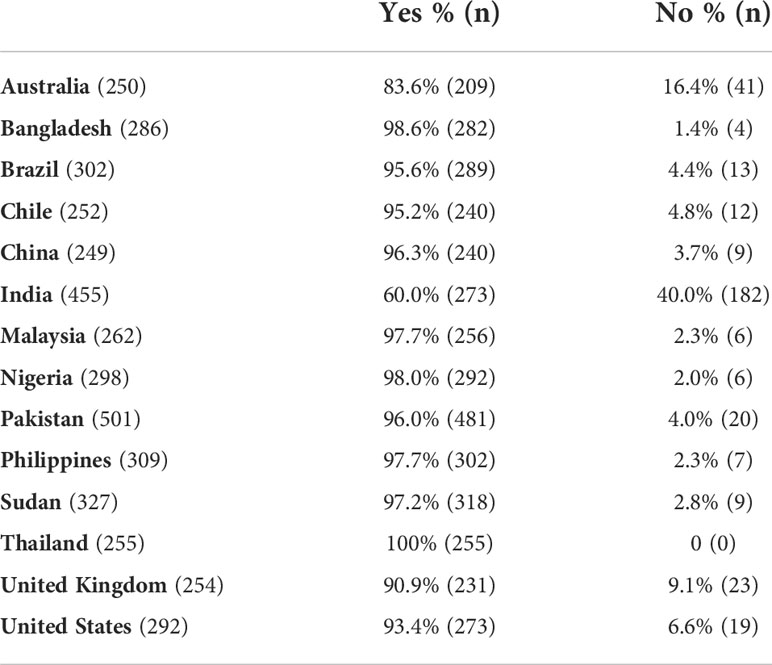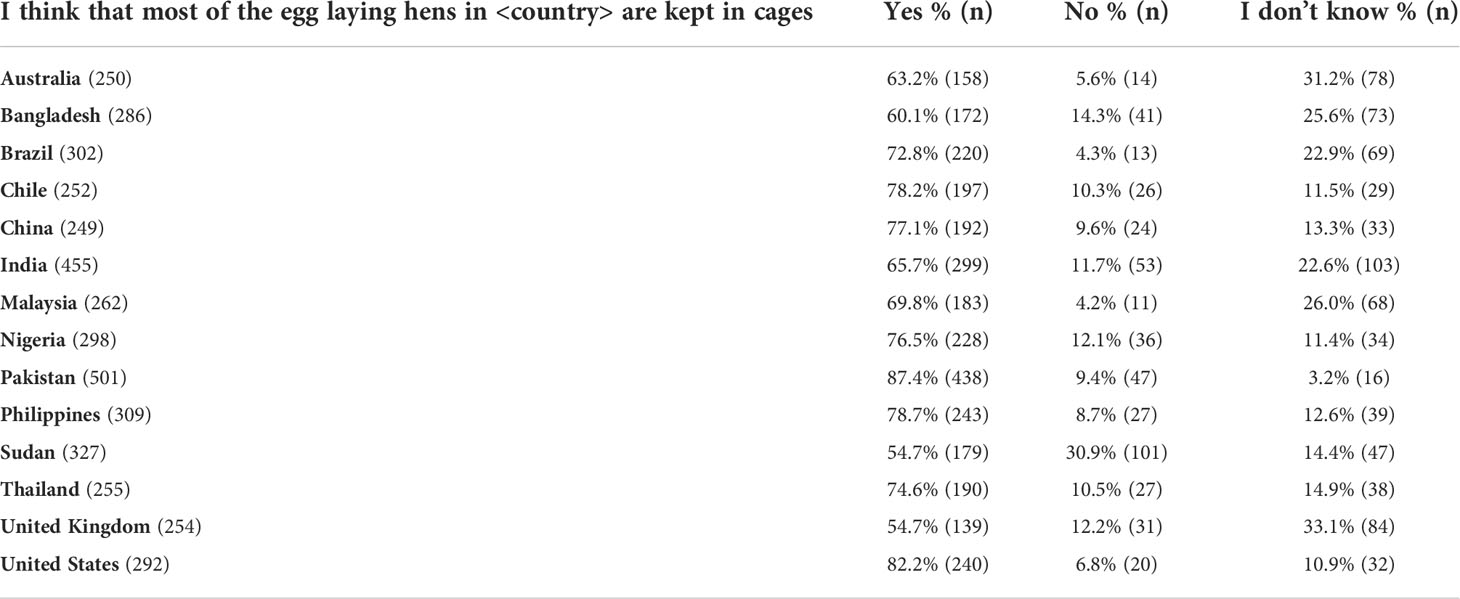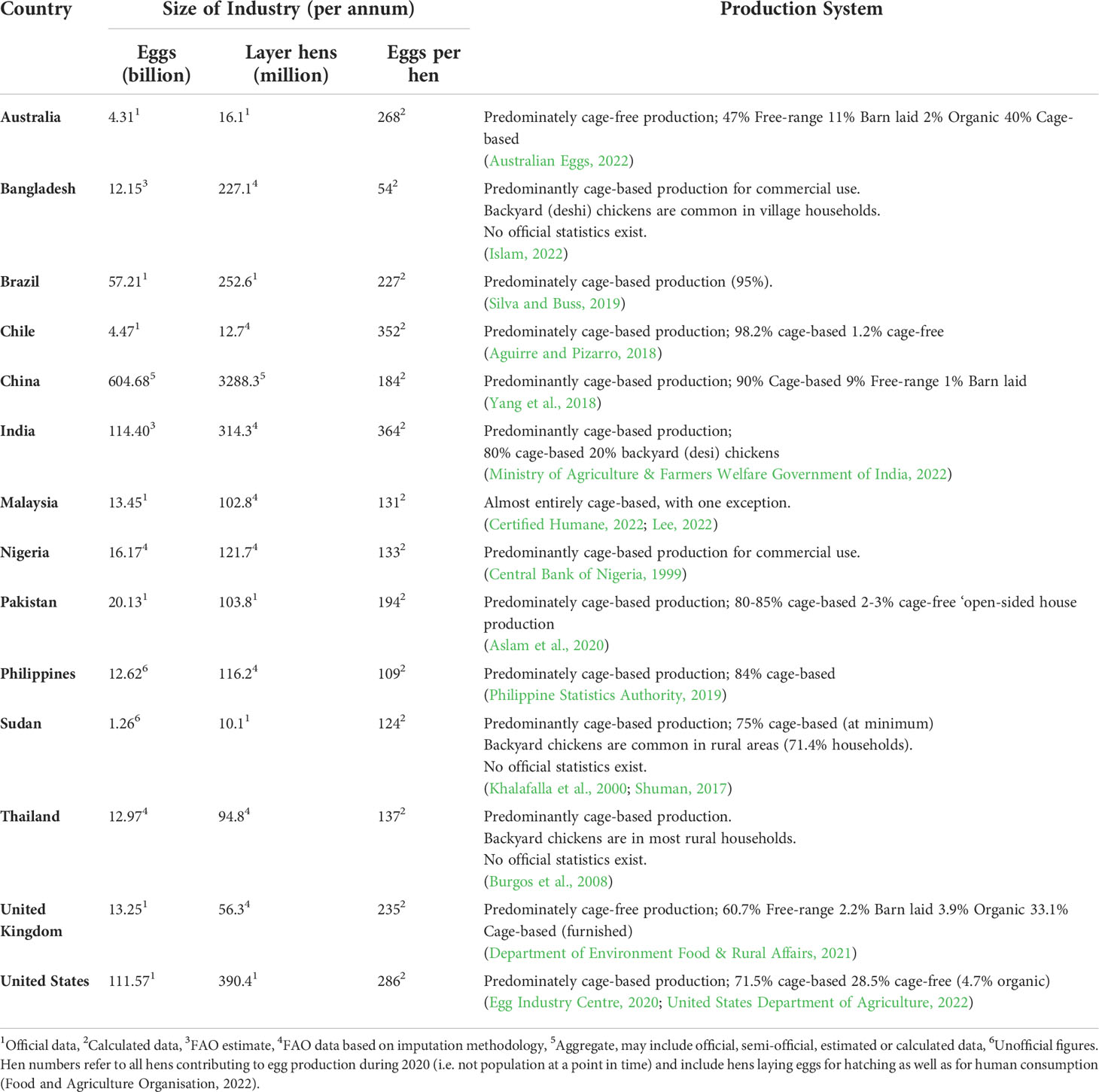Consumer attitudes towards egg production systems and hen welfare across the world
- 1Harvard Law School, Animal Law & Policy Program, Harvard University, Cambridge, MA, United States
- 2School of Veterinary Sciences, University of Queensland, Brisbane, QLD, Australia
- 3Asia Animal Happiness Consultancy, Puchong, Selangor, Malaysia
- 4Laboratório de Etologia Aplicada e Bem-Estar Animal, Universidade Federal de Santa Catarina, Florianópolis, Brazil
- 5Department of Basic Veterinary Sciences, College of Veterinary Medicine, University of the Philippines Los Baños, Los Baños, Philippines
- 6Himachal Pradesh Animal Husbandry Department, Veterinary Polyclinic, Himachal Pradesh, Shahpur, India
- 7Faculty of Veterinary and Animal Sciences, The Islamia University of Bahawalpur, Bahawalpur, Pakistan
- 8Department of Veterinary Medicine, Bangladesh Agricultural University, Mymensingh, Bangladesh
- 9Department of Animal Physiology, Federal University of Agriculture, Abeokuta, Nigeria
- 10Departamento de Medicina Veterinaria, Universidad Católica de Temuco, Temuco, Chile
- 11Department of Animal and Veterinary Sciences, Botswana University of Agriculture and Natural Resources, Gaborone, Botswana
- 12School of Environmental and Rural Science, University of New England, Armidale, NSW, Australia
- 13Centre for Planetary Health and Food Security, Griffith University, Brisbane, QLD, Australia
- 14United States Department of Agriculture - Agricultural Research Service, Livestock Behavior Research Unit, West Lafayette, IN, United States
Concurrent with the growth of the human population, global egg production has experienced exponential increase in the last 50 years. This exponential growth has been made possible through the refinement of intensive egg production systems, predominately, conventional cages. The significant amount of liberties conventional cages withhold from hens has also formed the basis of growing challenge to the industry in many countries, with some major regions such as the European Union making sweeping regulatory reform. These reforms were driven by well-organised animal advocacy groups, fuelled by aligning consumer attitudes and behaviours. In the absence of concerted hen welfare advocacy and cage-free movement in much of the rest of the world, it is difficult to know what consumer attitudes and knowledge may exist outside the European Union. This study aimed to contribute to this knowledge by surveying 4,292 members of the public at random across 14 geographically and culturally diverse countries (Australia, Bangladesh, Brazil, Chile, China, India, Malaysia, Nigeria, Pakistan, Philippines, Sudan, Thailand, UK and USA). The findings show that most participants across all countries eat eggs, most state that it matters to them that hens do not suffer in the process of producing the eggs they eat, and importantly, a majority of participants in most countries (except Nigeria) would prefer (to varying degrees) to purchase eggs from hens not kept in cages. Participant knowledge of the dominant system of egg production in their country varied greatly, with frequent uncertainty. This suggests a need for clarity and consistency in communication to consumers during campaigns, in order to mitigate confusion. Most importantly, although these similarities existed across the countries, important regional differences were also present. This underscores the importance of understanding animal and agricultural issues by geopolitical region, and of locally tailoring strategy. The findings of this research will be of strategic use to egg producers and animal welfare advocates alike in understanding and appropriately catering to consumers in the future.
Introduction
Global egg production has experienced exponential increase in the last 50 years. While demand for milk has doubled over the past five decades (× 2.26) and the demand for meat has tripled (× 3.34), the demand for eggs has increased almost four and a half times (× 4.45) (Food and Agricultural Organisation, 2022a). Although the egg industry continued to grow throughout a global pandemic (Research and Markets, 2021), it is a trend that is forecast to face challenge (Gautron et al., 2021).
The exponential growth of egg industries in relation to other agricultural sectors has been made possible through the adoption of intensive egg production systems, predominately, conventional cages. The freedom of movement and restriction of behavioral needs that conventional cages withhold from hens has also formed the basis of growing challenge to the industry in many countries. A substantial body of scientific literature concurs that the use of these commonplace intensive systems causes poor animal welfare (Lorenz, 1980; Fraser et al., 2001; Appleby et al., 2004; Duncan, 2004; Webster, 2005; Hartcher and Jones, 2017). The extreme confinement restricts the expression of natural behaviours, such as stretching wings, perching, dust bathing, nesting, exploration, foraging and even basic movements. As a physiological result of this extreme confinement, egg laying hens experience musculoskeletal weakness and a problematic reduction of bone density (Webster, 2004; Lay et al., 2011; Widowski et al., 2013), chronic diseases such as fatty liver (Lay et al., 2011; Widowski et al., 2013; Jiang et al., 2014; European Food Safety Authority, 2015), metabolic diseases, and spinal cord compression (Duncan, 2001). Furnished (sometimes referred to as ‘enriched’) cages have attempted to diminish some of these welfare issues but are still subject to consumer disapproval and pending legislation (European Commission, 2021). Laying hens in well managed cage-free systems, such as barns and free-range, have the choice to express most of their natural behavioural repertoire, and suffer lower incidences of osteoporosis, non-infectious diseases and certain bone fractures (Hartcher and Jones, 2017), though they may also have more keel-bone damage and other welfare issues such as feather pecking and cannibalism (Lay et al., 2011).
On account of the animal welfare concerns associated with the conventional egg industry, advocating wholescale transition away from conventional and furnished cage-based systems became a mainstay of the emerging animal welfare movement (RSPCA Australia, 2022; RSPCA UK, 2022; Eurogroup for Animals, 2022). The issue also provided a ‘first stop’ entry point for the general public to engage with the messaging of the modern animal welfare movement, with previous research presenting that hens confined to cages for egg production constituted a significant public concern (Heng et al., 2013; Bessei, 2018). In response, reform to egg production systems has been mandated through legislation in some countries (Bessei, 2018). Conventional battery cages have been banned in Europe since 2012 (European Commission, 2019), while Australia, Canada and New Zealand have commenced legal phase-out of conventional cages (Hartcher and Jones, 2017; Department of Agriculture, Forest and Fisheries Australia, 2022). Most eggs around the world, however, are still produced in conventional cages. This remains the case in some nations that have seen well-funded domestic public awareness campaigns based on animal welfare, such as the United States of America, where 75% of eggs are still produced in these systems (Compassion in World Farming, 2020).
The nature of egg production and the amount of attention that hen welfare is afforded in domestic policy and advocacy considerably varies around the world. In many nations it is common that childhood homes have chickens for eggs, meat or companionship, whereas in other nations, backyard chickens are scarce, or rarely seen. Furthermore, the level of public knowledge around egg production systems and the level of concern for laying hen welfare amongst the general public remains largely unknown in most areas of the world outside Europe.
As a general trend, constituents and consumers around the world are increasingly concerned about animal welfare and expect improved treatment and conditions for farm animals. As attitudes of the general public towards egg production and hen welfare have garnered significant challenges and practical implications to the egg industry in some areas of the world, understanding attitudes that will impact the egg market by region could prove crucially useful to egg producers and international animal welfare strategists alike. The objectives of this study were therefore to survey members of the public across 14 countries (Australia, Bangladesh, Brazil, Chile, China, India, Malaysia, Nigeria, Pakistan, Philippines, Sudan, Thailand, UK and USA) to understand their knowledge of, and attitudes toward, both egg production and hen welfare within their countries.
Method
Research ethics
This research was granted ethical approval through the University of Queensland in Australia (2020002752). Data collection was conducted between April and October 2021. Due to the active COVID-19 pandemic, additional precautions were taken, and some regional variations in data collections methods were required.
Research tool
A survey was hosted online on the Google Forms platform and consisted of 24 research questions and four demographic questions (identified gender, age group, education level and religion), see Supplementary File 1. This paper reports the 4 questions concerning egg production systems and laying hen welfare only. Before commencement, potential participants were presented with a statement of consent and continuation with the study required consent to be obtained (verbally or physically by clicking a box). Participants were first asked if they understood the meaning of animal welfare, after which the following definition was provided:
“The welfare of animals refers to how well an animal is coping with the conditions in which it lives. An animal has good welfare if its needs are being met and hence it is healthy, comfortable, well nourished, safe, able to express important behaviour and not suffering from unpleasant states such as pain, fear and distress” -adapted from World Organisation for Animal Health (OIE, 2016).
The 24 research items were designed to reveal participants knowledge and perceptions and consisted of a range of question styles. For the four egg production and hen welfare questions, two questions (“It matters to me that the chickens producing eggs do not suffer” and “I would prefer to buy eggs from chickens that have not been kept in cages”) required the participant to attribute a level of agreement utilising a 7-point Likert scale (1 – strongly disagree, 4 – neither agree nor disagree, 7 – strongly agree). Binary responses were required for one research question (‘do you eat eggs?’) and one knowledge question (‘most egg laying hens in this country are kept in cages’). All research items were pilot tested and revised with research team consultation to ensure they could be clearly translated and were appropriate within each of the study countries. In the version that was completed by individuals at home, facilitated through Mechanical Turk and Instagram (see Data collection for full description of methods), the research tool included the addition of a “mid-way attention tool” to assess that participants were answering accurately and not randomly clicking. Once programmed online in English, the survey tool was replicated for each of the countries, and translated by bilingual translators into languages suitable to each general population as follows; Australia (English), Bangladesh (Bengali), Brazil (Portuguese), Chile (Spanish), China (Traditional Chinese/Mandarin), India (Hindi and English), Malaysia (Bahasa Malay, Chinese and English), Nigeria (English), Pakistan (Urdu), Philippines (English), Sudan (Arabic) and Thailand (Thai).
Data collection
The main method of data collection in this study was face-to face-collection in public spaces. Data collectors in each country were instructed and supervised by local research familiar ‘Country Collaborators’, who are also co-authors of this study. Once randomly selected and approached by data collectors, prospective participants were asked if they were willing to complete a five-minute survey of opinions about animals for an international academic study. If the request was accepted, the data collectors ensured the participants were over 18 and that they identified themselves as residents of the country they were in. If they did not fulfill the required criteria, they were thanked for their time and collection was ceased. If they did fulfill the criteria and agreed to participate, they were advised of the confidential and anonymous nature of the research and advised that they could cease their involvement at any time during the survey. In this method of face-to-face collection, the data collectors then verbally presented each question to the participants and entered the response into the online survey tool where it was anonymously stored. While this method of collection was highly demanding of human resources, it was adopted to reduce the bias of self-selection. The eleven countries in which this method was used were Australia, Bangladesh, Chile, The People’s Republic of China (henceforth China), India, Malaysia, Nigeria, Pakistan, Philippines, Sudan and Thailand.
In addition to random approach in public spaces, in some countries it was necessary to adopt additional methods of recruitment, to ensure sufficient numbers, that presented reduced safety risk during periods of pandemic lockdown. In Malaysia and Australia, a QR code pamphlet that linked to the survey tool was randomly distributed to members of the public with a brief explanation of the study so they could complete the survey while maintaining social distance from the data collector.
Recruitment of participants in Brazil, United States (henceforth USA) and United Kingdom (henceforth UK) was conducted entirely online. Recruitment in Brazil was conducted utilising the social media platform Instagram (Meta Platforms et al., 2010). An advertisement (in Portuguese) saying “We want to hear from you. Access the link to collaborate with our research on the relationship between people and animals” was posted inviting the public to self-select and participate in the survey. The Instagram account was created exclusively to share the questionnaire and had no information on the identity of the authors or the research group. We strategically targeted participants to match the age and gender distribution of the Brazilian population and the questionnaire was initially pilot tested using 20 randomly recruited participants to ensure representative distribution was achieved. Participant recruitment for data collection in the USA and the UK was conducted utilising online platform Amazon Mechanical Turk (Bezos, 2005). Amazon Mechanical Turk offers a small payment (in this study, a scaled proportion of minimum salary for five minutes participation time) to ‘workers’ previously enlisted with the platform in exchange for completing the survey. Amazon Mechanical Turk has been previously validated as a survey participant recruitment tool (Robbins et al., 2016), with samples providing more diversity with comparable quality measured against standard samples (Paolacci and Chandler, 2014).
Data analysis
The data were initially collated, organised and cleansed by removing incomplete datasets and all data from participants who did not pass the midway attention test (see Research tool). Data were imported into Microsoft SQL Server and Microsoft Excel for cleaning, and IBM SPSS and Minitab (Minitab Statistical Software LLC, 1972) where descriptive statistics were obtained for the demographics and research items. Based on the Likert scale (1-7), all attitudinal questions were assessed for means to approximate magnitude of agreement for statement items, or associated importance for species specific animal welfare perceptions (Norman, 2010). Variance between countries for each question was assessed with a one-way ANOVA, with a post hoc Tukey pairwise analysis test performed to assess homogeneity between countries. Where means of question responses or groups were compared, a Student’s t-test was used. Percentages of agreement were also calculated by identifying and quantifying the number of participants who expressed some level of agreement (5, 6 or 7 values), against those who expressed disagreement (1, 2 or 3 values) or neutrality (4 value). Both calculations are presented together in the results tables to build a picture of general agreement/associated importance, and strength of that agreement/associated importance.
Results
A total of 4,292 participants engaged in this study, across 14 geographically and culturally diverse countries (Australia, Bangladesh, Brazil, Chile, China, India, Malaysia, Nigeria, Pakistan, Philippines, Sudan, Thailand, UK and USA). Demographic distribution within these countries is presented in Supplementary File 2. Although distribution varies across countries, the total sample was closely split by gender (49.55% identified as male, 47.89% as female). Most participants were between 18 and 49 years of age. Participants with a university education are overrepresented as compared to the general population, however this is a consistent effect across countries.
Most participants across all countries ate eggs, which is accurate in comparison to the general populations (Table 1). Those who did not consume eggs were overrepresented by approximately 9% in India; 40% in this study compared to the last recorded census at 31% (Yadav and Kumar, 2012), and Australia; 16.4% in this study compared to 7% recorded by the Australian Egg Industry (Australian Eggs, 2017).
Participants generally agreed that most eggs in their country are produced in cage-based systems, with some degree of difference across the countries (Table 2). Although the egg industries of the 14 countries included in this study vary greatly in terms of industry size and efficiency (Table 3 and Figure 1), most eggs are produced in cage-based systems in most countries in this study except Australia and the UK. Here, the opposite is true with only 40% and 33.1% of eggs in these countries respectively produced in cages, with the UK only allowing the use of furnished cages. Over 50% of eggs are produced in cages in all other countries in this study, often much closer to 100% (Table 3).
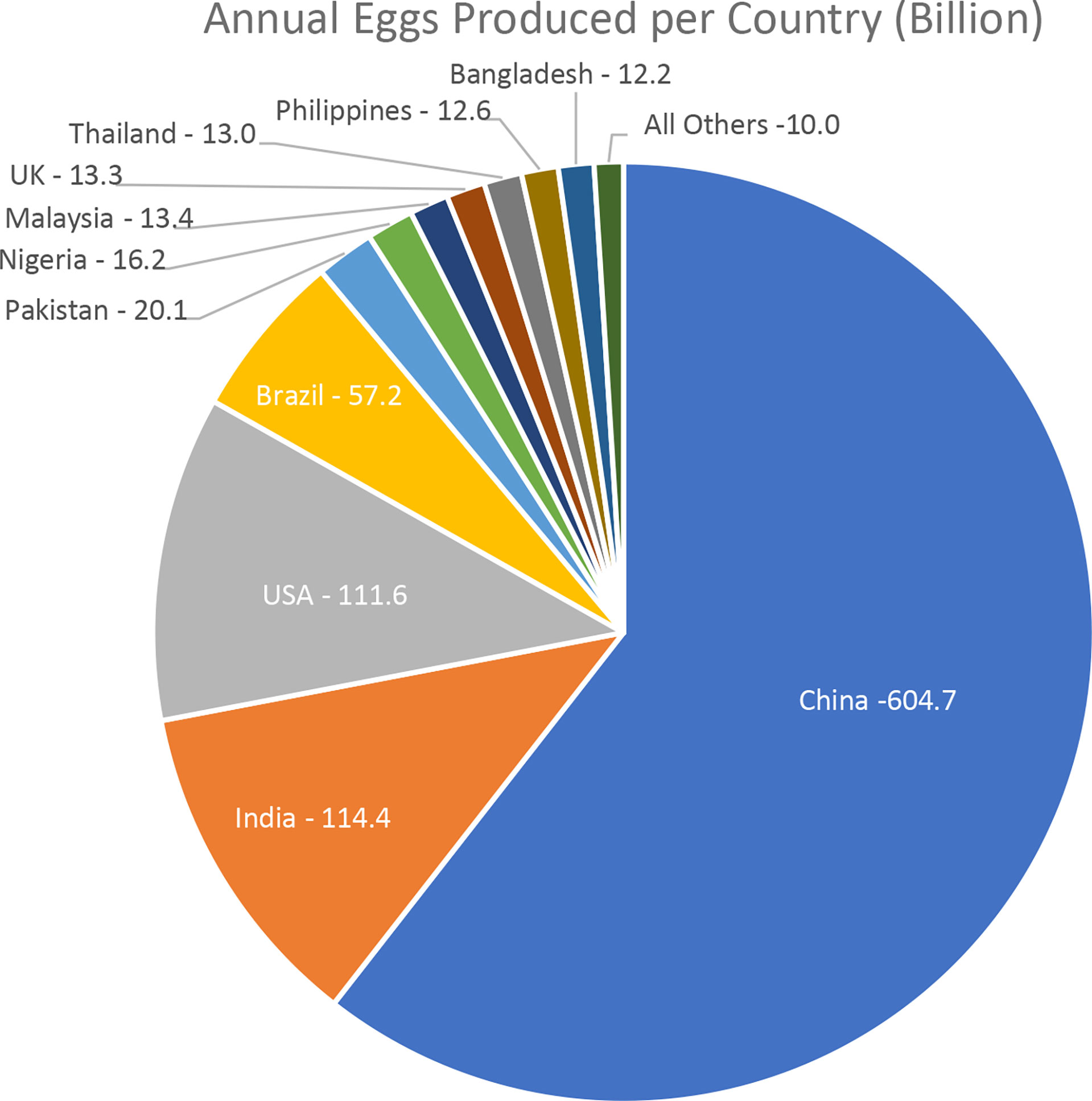
Figure 1 Egg production by country, by billion eggs. Data from FAOSTAT (Food and Agriculture Organisation, 2022a).
A majority of participants across all countries surveyed, apart from Bangladesh, agreed that it mattered to them that egg producing chickens should not suffer (Table 4 and Figure 2 - Mean 5.67, SD 1.67). This was also reflected in the mean Likert scores (Table 4). Based on Likert scores, the countries formed three significantly different groups. Chile, Brazil and Australia formed a group with the highest mean Likert scores, meaning they most strongly agreed that egg-producing chickens should not suffer. At the other end, Bangladesh was alone in being ambivalent that egg-producing chickens should not suffer. The rest of the countries were grouped together in also agreeing that egg-producing chickens should not suffer, but not as strongly as the first group. More information pertaining to the results of Tukey’s analysis for this item can be found in Supplementary File 2.
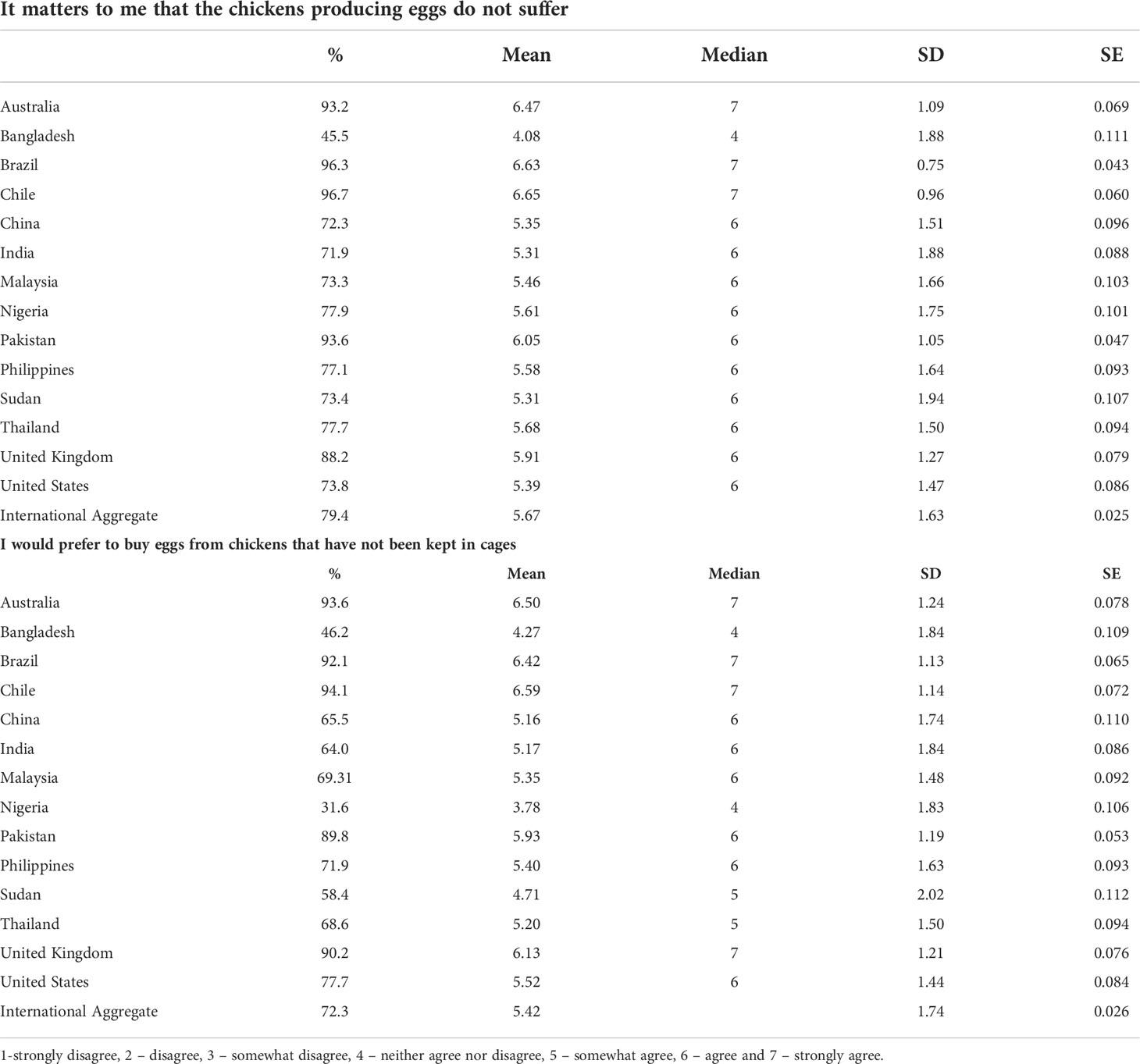
Table 4 Means for the level of agreement with animal welfare focused statements regarding egg production by country, utilising 7-point Likert scale, and percentage of general agreement with statement.
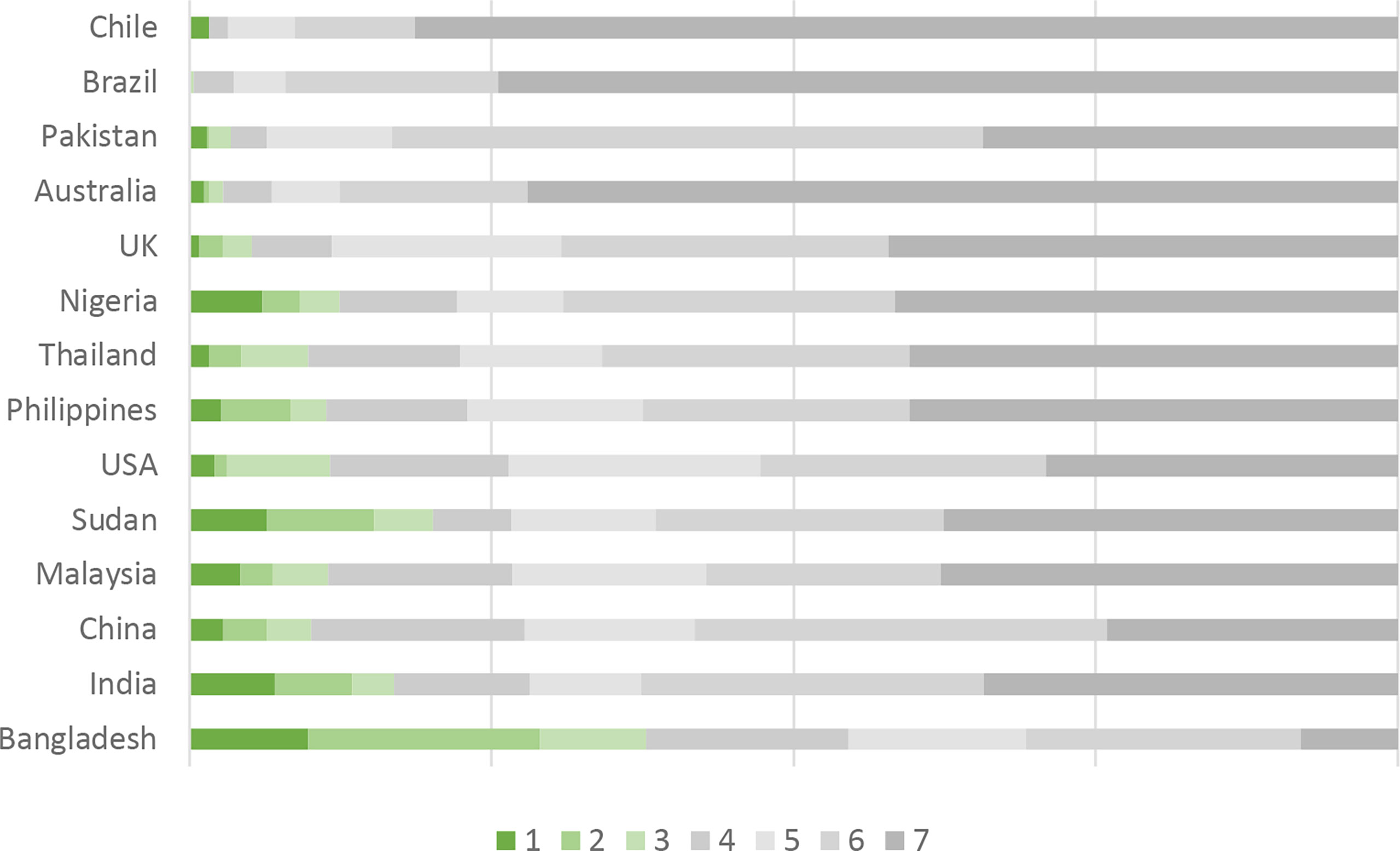
Figure 2 Responses to the question “It matters to me that the chickens producing eggs do not suffer” coloured by Likert response (1 – Strongly Disagree, 2 – Disagree, 3 – Somewhat Disagree, 4 – Neutral, 5 – Somewhat Agree, 6 – Agree, 7 – Strongly Agree) and sorted by general agreement.
A majority of participants across all countries surveyed, apart from Nigeria, agreed that they would prefer to buy eggs from chickens that have not been kept in cages (Table 4 and Figure 3 – Mean 5.42, SD 1.74). This was also reflected in mean Likert scores (Table 4). Based on Likert scores, the countries formed less distinct groups for responses to this question, Nigeria, Bangladesh and Sudan had low scores that were significantly different from each other, and all other countries. At the high end, Chile, Australia and Brazil again grouped together, strongly agreed that they would prefer to buy eggs from cage-free chickens and had significantly higher scores than all other countries except the UK. The rest of the countries grouped in the middle, also agreeing to prefer cage-free eggs, but not as strongly. More information pertaining to the results of Tukey’s analysis for this item can be found in Supplementary File 2.
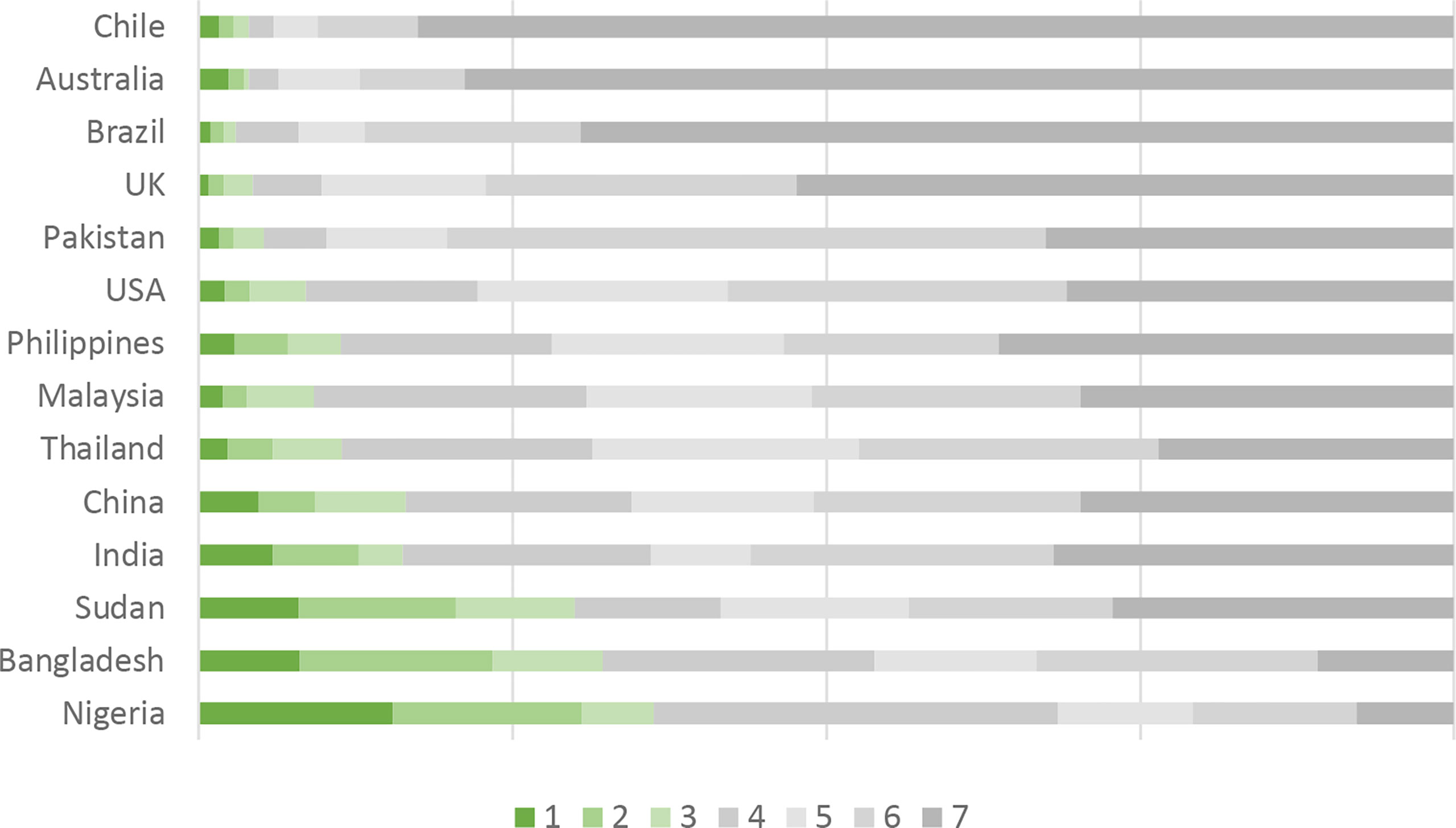
Figure 3 Responses to the question “I would prefer to buy eggs from chickens that have not been kept in cages” coloured by Likert response (1 – Strongly Disagree, 2 – Disagree, 3 – Somewhat Disagree, 4 – Neutral, 5 – Somewhat Agree, 6 – Agree, 7 – Strongly Agree) and sorted by general agreement.
In general, levels of agreement and Likert scores for both questions were correlated. For percent agreement for all countries, the degree to which suffering was deemed to matter was closely matched by the likelihood of preferring cage-free eggs (R2 = 0.576, p<0.01). For Likert scores for all countries, the degree to which suffering was deemed to matter was closely matched by the likelihood of preferring cage-free eggs (R2 = 0.623, p<0.001 - Figure 4). Both these relationships would be stronger (R2 = 0.891 and R2 = 0.890 respectively) if data from Nigeria were excluded. Participants in Nigeria expressed substantial agreement that it matters that egg laying chickens do not suffer (77.8% agree), however generally disagreed that they would prefer eggs from chickens not in cages (only 31.5% agree).
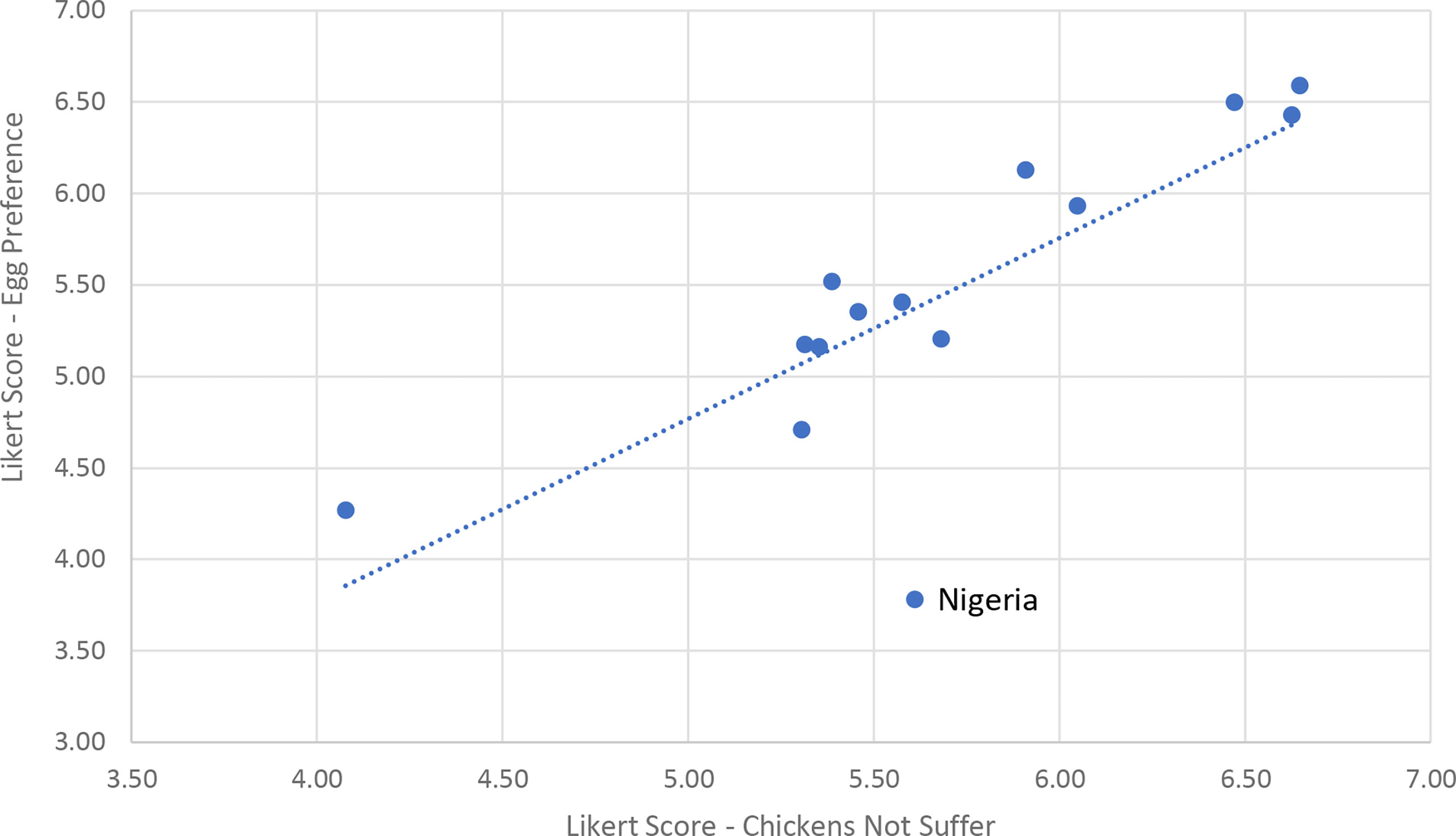
Figure 4 Scatter Plot modelling “I would prefer to buy eggs from chickens that have not been kept in cages” (Y) against “It matters to me that the chickens producing eggs do not suffer” (X) for all countries (R2 = 0.623).
Whether participants ate eggs or not was not a good predictor of whether they had strong concerns about the welfare of egg producing chickens (P=0.61) or whether they preferred eggs from uncaged chickens (P=0.89) when tested using a one-way ANOVA. However, participants who thought more hens were kept in cages did answer these questions significantly differently – those who answered “Yes” were more likely to agree that egg welfare was important (Mean 5.77 vs Don’t know 5.57 and No 5.15 P<0.001) and even more variation in that they would prefer cage free eggs (Mean 5.54, Don’t Know 5.30, No 4.82 P < 0.001).
Finally, the Likert score for the preference to buy eggs from cage-free systems was positively correlated with the calculated production efficiency of eggs/hen/year (R2 = 0.383, Figure 5). Also the Likert score for the preference to buy eggs from cage-free systems was positively correlated with the United Nations Human Development Index (HDI) value (R2 = 0.444, Figure 6), whereas the Likert score for the laying hens should not suffer showed no correlation with the HDI value (R2 = 0.156, Figure 6).
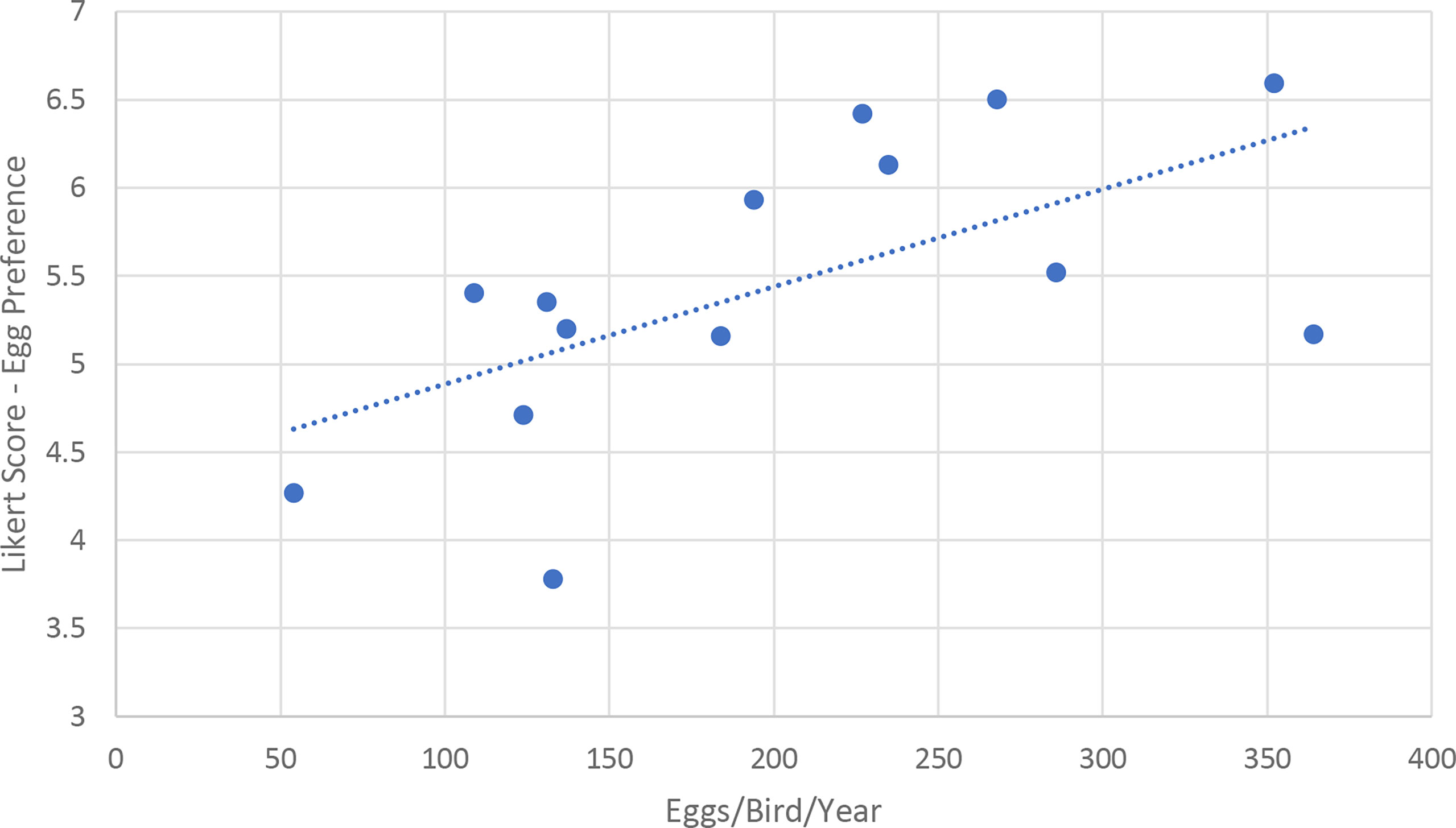
Figure 5 Scatter Plot modelling “I would prefer to buy eggs from chickens that have not been kept in cages” (Y) for all countries against “Eggs produced per hen per year” (R2 = 0.383).
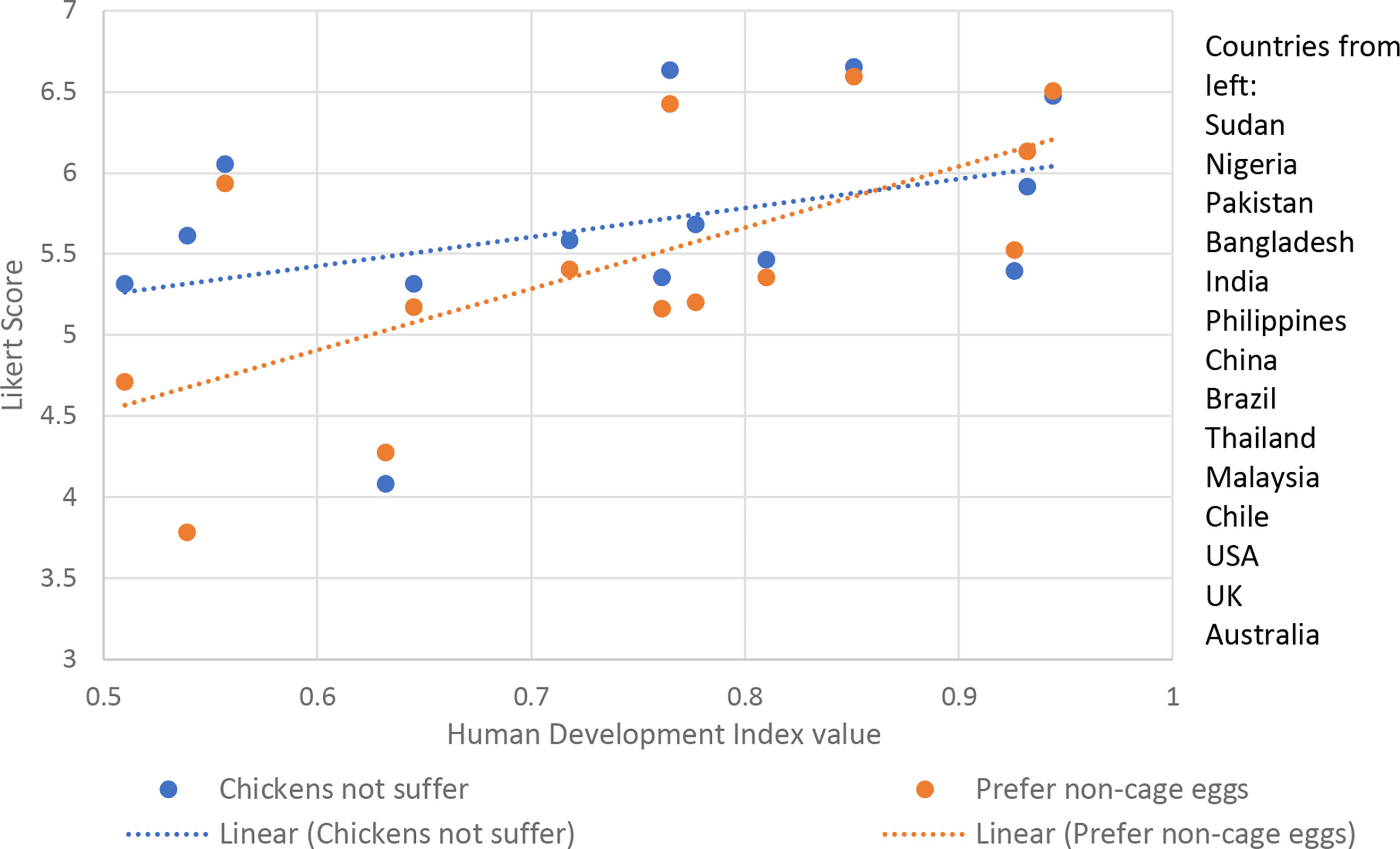
Figure 6 Scatter Plot modelling Human Development Index value against Likert scores for “It matters to me that the chickens producing eggs do not suffer” (R2 = 0.156, ns) and “I would prefer to buy eggs from chickens that have not been kept in cages” (R2 = 0.444, p<0.01).
Discussion
Summary of Key Findings
● Most participants across all countries eat eggs.
● The majority of participants across all countries except Bangladesh stated that it mattered to them that the chickens producing eggs do not suffer.
● Participants in Australia, Brazil, Chile, Pakistan and the UK had the highest percentage and mean level of agreement that it mattered that hens do not suffer, and that they would prefer to purchase cage-free eggs.
● Participants in Bangladesh did not tend to agree that the suffering of hens matters and have only a slight preference for cage-free eggs.
● Some countries had disparity between caring about welfare and preference for cage (most notably Nigeria), indicating some believe cage systems deliver better hen welfare/hens do not suffer. In some instances, this could also imply that ‘cage-free’ carries varied hen welfare implications depending on the predominating perception of what ‘cage-free’ is in these regions. Where this is the case, further research is recommended to ascertain the nature of these perceptions, and awareness increasing initiatives may then be indicated.
● Many participants were not certain if cage or cage-free systems were predominant in their country. Where this is the case, awareness is prescribed.
● Participants in Australia and the UK had the highest frequency of uncertainty if cage or cage-free systems were predominant in their country, despite being the only countries in which a majority of eggs are not produced in cages. This could reflect consumer confusion and underscore the importance of clear consistent labelling, marketing and advocacy messaging.
● In some nations where high-level awareness campaigns have been conducted with the general public and policy or regulation has been enacted, transition away from cage-based systems is seen.
● In many countries eggs produced in cage-free systems may not be readily available; however, the findings of this study suggest consumers in these areas would prefer eggs produced this way, and that a market exists. This represents an opportunity for the egg industries in these areas.
● The high levels of agreement that hen suffering matters and the preference for cage-free eggs seen in most countries in this study could serve as a prompt to egg industries to make changes. In order to future-proof their enterprises, it seems prudent to begin investigating and investing in higher welfare systems and practices as opportunities present themselves to do so.
● Most importantly, while some similarities exist across most countries, important regional differences also exist. This again underscores the need to understand animal and agricultural issues by geopolitical region, and to develop strategy locally.
In most countries around the world, bird eggs constitute a consistent commonality in the human diet (Food and Agricultural Organisation, 2022b). Of the countries in this study, China, India, USA and Brazil produce the most eggs, first, second, fourth and fifth in the world respectively (Food and Agricultural Organisation, 2022a). With 604.7 billion eggs, China produces significantly more than all other top five producing countries combined and 5.3× more than their closest competitor India, which produces 114.4 billion eggs (Food and Agricultural Organisation, 2022a - Figure 1). Three of these four highest production countries in our study almost entirely employ cage-based systems (with the exception of the USA at 71.5% cage-based; see Table 3), and none have consistent regulations in regard to space requirements aimed at improving hen welfare.
Nearly all the participants across all countries in this study stated that they eat eggs. One exception to this was India, in which only 60% of participants claimed to eat eggs, with the last reliable statistic from the region suggesting 69% of Indians eat eggs (Yadav and Kumar, 2012). This exception is unsurprising in a country in which vegetarianism is widely practiced as a religious tenant of Jainism and across many sectors in Hinduism (Yadav and Kumar, 2012) and many Hindus consider eggs to be like meat. Eighty-six percent of Indian participants in this study identified themselves as Hindu. This study demonstrates that egg consumption is commonplace across cultures, with very few people abstaining unless for reasons of regional religiosity.
Alongside high levels of egg consumption, however, is a relatively high level of stated concern for the welfare of the birds expected to produce these eggs, regardless of the country’s HDI value. With the exception of Bangladesh (discussed further below), participants across all countries agreed to some level that it mattered to them that chickens producing eggs do not suffer. This serves to reinforce previous findings that most people, across cultures, state that they care about animal welfare (Sinclair et al., 2017; Anderson and Tyler, 2018; Sinclair et al., 2022) and that kindness is a core human capacity and forms a primal evolutionary purpose for humans in general (Sampson, 2003; Crowe, 2017). This optimistic finding, however, was not necessarily matched in knowledge around what systems of production were dominant in each country, and consistency around association between cage-based systems and hen suffering. To offer country specific context against which to measure knowledge responses, Table 3 was created with references, and Figure 1 was created to demonstrate the size of egg production industry in each country. In Brazil, Chile, China, Nigeria, Pakistan, Philippines, Thailand and the USA, participants had high levels of accurately identifying that most eggs produced in their country were from cage-based systems (>70%). The reasons for this are unknown, but could include the existence of domestic cage-free campaigns (Brazil and Chile), the presence of a significant export market that has impact on gross domestic product (Brazil, China, Philippines and Thailand) and therefore exposure to or awareness of the commercial industry due to its scale, or exposure due to a rural proximity to primary agriculture in lesser developed countries where subsistence farming is common (Nigeria and Pakistan).
Participants in the USA were the most likely to confidently (and accurately) state that most eggs in the country were produced in cages. However, the reported USA concern levels for the welfare of egg laying hens, and the preference for cage-free eggs were less than the other culturally-related, high-income countries in this study (approximately 20% less compared with the UK and 15% with Australia). Seventy-one and a half percent of eggs produced in the USA remain cage based. With the exception of some state-based legislation - such as that found in California, where conventional cage systems are outlawed and Californian Proposition 12 will restrict the movement of eggs produced in cage systems into the state (State of California, 2018) unless overturned by the Supreme Court – the USA is also mostly without restriction in terms of hen welfare requirements in egg production. This finding is consistent with a previous in-house survey by Faunalytics; one in which the general public in the USA had lower pro-chicken attitudes as compared to those in Brazil and China (Wulderk et al., 2022); another in which USA students studying in the UK scored amongst the lowest when associating sentience to chickens as compared to British students and ex-pats from 14 other countries (Phillips and McCulloch, 2005), and lastly in separately published findings within the present study in which USA respondents associated the lowest mean importance to the welfare of chickens as compared to all other countries, only slightly above fish and sharks (Sinclair et al., 2022b). The lack of legislation may in part be explainable by the diversity of culture, political alignment, and legislative process between the individual states throughout the country, as animal welfare most commonly falls under state-based jurisdictions. Although USA respondents were less likely to state they cared about hen welfare than Australian and UK participants, three quarters still stated they do care, potentially signalling significant tensions to arise in the future.
While in most countries the level of care was correlated with a preference for cage-free eggs, there are some important exceptions – specifically from the countries in this study with the lowest Human Development Index value. In the case of Nigeria, most participants agreed that chickens should not suffer while they produce eggs, yet conversely stated they were also unlikely to prefer eggs from cage-free systems of production – the system of production designed to address hen welfare issues. A similar dynamic appears in Sudan to a lesser degree. This could indicate that cage-based systems are not always associated with poor hen welfare in these areas, and potentially, the opposite; intensive cage-based systems are sometimes associated with higher welfare. Cage-based systems allow for uniform management of flock health and the ready administration of medical dosing (United Egg Producers, 2022), however an interpretation in which this in itself constituted superior animal welfare would rely on a definition of ‘animal welfare’ that sits solely with physiological wellness. That is, that the birds are easily kept alive and parasite free, but fail regarding psychological wellness, ability to perform some highly motivated natural behaviours and a life worth living. In this case, it could indicate reduced awareness around animal welfare in general, such that fundamental awareness campaigns and messaging could be useful.
Other factors that may influence Sudanese and Nigerian participants’ opinion regarding cage-free eggs is that caged eggs, or intensive production systems, may be seen as a route to making eggs readily available and affordable (Morris et al., 2018) and also safer (Agbaje et al., 2021). Of the countries included in our study, Nigeria, Sudan and Bangladesh are the only ones to have a low availability of eggs (Morris et al., 2018) combined with very expensive Relative Caloric Prices – that is the price of a calorie from eggs relative to a calorie from starchy staple foods, such as wheat, rice, maize, millet and sorghum (Headey and Alderman, 2019). It is perhaps not surprising therefore, that where access to affordable eggs is low, cage systems may be seen as a way to change this and hence a preference for cage-free eggs is greatly reduced. The perception of food safety may also influence this choice in Nigeria, despite the findings of a previous local study in that eggs from egg farms (75% of which were cage-based operations) were more contaminated with Salmonella than eggs from small holder markets (Agbaje et al., 2021).
In the unique case of Bangladesh, participants tended to not agree that the suffering of egg laying chickens mattered to them, however they slightly agreed that they would prefer to buy eggs from chickens that have not been kept in cages. Bangladesh sits at rank 133 in the Human Development Index, the lowest of countries in this study after the aforementioned countries of Sudan, Nigeria and Pakistan (United Nations Development Programme, 2020) and one of those countries to have a low availability of eggs combined with very expensive Relative Caloric Prices. Although the commercial industry is mostly cage-based production, cage-free chickens are often kept in village households for family subsistence, and as a transactional resource (Islam, 2022). Interpreted in the context of wider literature (Sinclair et al., 2019), a preference for cage-free eggs in the absence of concern for the welfare of the hens could indicate a loyalty to supporting the livelihood of local communities and their cage-free village hens. A similar dynamic is seen in the USA to a slight degree, potentially indicating that USA participants may have additional reasons for choosing cage-free eggs on occasion. This could be explainable by an increase in ‘organic’ marketing and sales in the USA, and a resulting perception by some consumers that organic indicates increased health properties (Lim et al., 2014). Further qualitative research could shed further light on this dynamic.
The UK and Australia are the only countries in this study in which the market share of eggs produced in cage-free systems currently outweighs that of cage-based systems (see Table 3). Participants in these countries also scored amongst the highest in level of care, with the most closely matched stated preference for cage-free eggs. In addition to a matter of cage-free egg availability, this is likely to also be a result of historical animal advocacy campaigns. In both countries large scale cage-free egg consumer campaigns successfully reduced market engagement with cage-based eggs, minimum standards exist for stocking density in both cage-free and cage-based systems, and egg products are required to be labelled to show the system they come from (Australian Eggs, 2018). Despite this positive engagement, participants in both the UK and Australia were also the most likely to state that they did not know what egg production system was most prominent in their country (around a third of participants in both instances). Both countries are also currently experiencing news and public debate relating to egg production systems. In Australia, substantiated instances of misrepresentation on consumer labelling have resulted in new legislation defining standards that must be met in order for producers to label their product ‘free-range’. This includes legislation on the use of misleading pictures or names (Australian Competition and Consumer Commission, 2018). The UK, the only country in this study that has outlawed and phased out conventional ‘battery’ cages entirely (Government of the United Kingdom, 1999), is currently participating in a renewed Europe-wide ‘end the cage’ campaign and petition to parliament. This initiative aims to legislate against ‘furnished’ cages, a form of cage-based production that allows for increased space and the expression of some natural behaviours as compared to outlawed conventional cages (Government of the United Kingdom, 2022). Improved labelling, such as directly stamping eggs according to the housing system in which they were produced as is required in Europe could contribute to clarity for consumers in this regard (European Commission, 2008).
It is perceivable, given the findings of this study, that while success of large-scale, egg-focused, animal advocacy campaigns has been wholly positive in both the UK and Australia, that they may have also contributed to a lack of confidence in consumers around the current status of their respective egg industries, also confounded by a lack of confidence regarding labelling. These two cases may suggest that sustained animal advocacy campaigns in relation to animals in severely restricted cages have the potential for widespread success in vastly improving living conditions for hens; however, to sustain consumer awareness, and potentially therefore engagement, that messaging would benefit from being clear and consistent. It is also important to note that some disparity is likely to exist between individual perceptions of ‘cage-free’. In the USA, for example, previous studies identified that a misunderstanding of ‘cage-free’ (typically indoor ‘barn laid’ systems) as synonymous with ‘free-range’ (implying outdoor access) was common (Ochs et al., 2018; Ochs et al., 2019). An understanding of cage-free as outdoors and therefore subjected to predation and weather events could offer an additional explanation for Nigerian respondents stating a preference for cage eggs. Further focus group research allowing for a deeper understanding of these perceptions would provide useful prior to the introduction of domestic laying hen welfare initiatives in each respective region.
For producers in all countries, the findings of this study support the recommendation that adopting higher welfare systems and practices may be prudent in order to stay on trend and to safeguard their enterprise from future scrutiny and limiting regulation (Compassion in World Farming, 2013; Future Beef, 2018), and lift public perception of animal agriculture industries in general (Grandin, 1995; Grandin, 2015). This is particularly the case in countries with burgeoning animal welfare fields and in countries with a consumer preference shift toward quality above quantity correlated with increased affluence, such as China (Sinclair et al., 2022a), Brazil and Chile (von Keyserlingk and Hötzel, 2015). In all countries in which participants placed significant agreement that avoiding the suffering of egg laying hens mattered to them personally, and that they would prefer to purchase eggs not from cages (all countries except Bangladesh and Nigeria), market opportunity exists for producers to diversify their produce by transitioning to or incorporating higher welfare systems. This opportunity is particularly noteworthy in countries where cage-free eggs are not readily commercially available (China, India, Malaysia, Pakistan, Philippines, Sudan and Thailand), and therefore a significant gap in this market currently exists. In considering transition away from battery cages it is advisable for egg industries to reflect on the experiences of regions in which this transition is progressed (ie, Europe); larger or furnished cages are no longer considered acceptable to most customers, and therefore it is advisable to directly invest in cage-free systems rather than incur the cost of a middle-ground option that may not be sustainable long term (Weary et al., 2016). Furthermore, any transition away from cage systems may benefit from cross-sector collaboration (Rodenburg et al., 2022).
Conclusion
Across 14 culturally, geographically and politically diverse countries, most of the 4,292 participants in this study eat eggs, and also state that it matters to them that hens do not suffer in the process of producing the eggs they eat. Importantly, a majority of participants in most countries (except Nigeria) would prefer, to varying degrees, to purchase eggs from hens not kept in cages. In many of these countries, cage-free eggs may not be readily commercially available, and therefore this represents an optimistic market opportunity to underscore a transition to higher welfare and cage-free systems. Participant knowledge of the predominating system of egg production in their country varied greatly, with frequent uncertainty; most noticeably in the UK and Australia, the only countries in this study that largely produce eggs in cage-free systems. This suggests a need both for clarity and consistency in communication to consumers during campaigns in order to mitigate confusion and for caution in egg labelling. Although some similarities exist across most countries, important regional differences also exist. Supporting the growing body of international animal welfare literature, this finding further underscores the need to understand animal and agricultural issues by geopolitical region, and to develop and tailor strategy locally. The findings of this research not only serve as a cautionary indicator for egg producers on preferences and potential trends of consumer markets, but also opportunity for market development. In addition, the findings of this research are anticipated to be of use to animal advocates in refining strategic initiatives in these regions.
Data availability statement
The raw data supporting the conclusions of this article will be made available by the authors, without undue reservation.
Ethics statement
The studies involving human participants were reviewed and approved by University of Queensland Human Ethics Committee. The participants provided their informed consent to participate in this study.
Author contributions
MS conceptualized the study, sourced funding, recruited the research team, administered the project, developed the research tool, analyzed the data and wrote the paper. NL, ML, AS, MI, OI, GO, and AA coordinated local data collection, provided advice on the localization of methodologies, provided interpretation of results within the local context and proof-read the paper. MH coordinated local data collection, provided advice on the localization of methodologies, provided interpretation of results within the local context and edited the paper. MC constructed statistical models and analyzed the data. GB conducted data collection, provided methodological advice and edited the paper. JM gave methodological advice, provided interpretation of results within the local context, contributed to writing the paper and edited the paper. All authors contributed to the article and approved the submitted version.
Funding
Open Philanthropy facilitated funding provisions for research expenses under the Animal Welfare Standards Project.
Acknowledgments
The authors would like to acknowledge Harvard Law School Animal Law & Policy Program, who hosted the lead author (Dr. Michelle Sinclair) and this research project. The authors also wish to draw attention to the concentrated efforts of some members of the in-country data collection teams; Dr. Jea Agnes Buera in the Philippines, the Animal Science class of 2021 at The Islamia University of Bahawalpur in Pakistan, The “Animal Welfare House” at the Department of Veterinary Medicine at Bangladesh Agriculture University, Anubhuti Jain in India, Dr. Saber Y Adam in Sudan and Tessa Derkley and Alison Pendlebury in Australia.
Conflict of interest
Author NL was employed by Asia Animal Happiness Consultancy.
The remaining authors declare that the research wasconducted in the absence of any commercial or financial relationships that could be construed as a potential conflict of interest.
Publisher’s note
All claims expressed in this article are solely those of the authors and do not necessarily represent those of their affiliated organizations, or those of the publisher, the editors and the reviewers. Any product that may be evaluated in this article, or claim that may be made by its manufacturer, is not guaranteed or endorsed by the publisher.
Author disclaimer
The findings and conclusions in this publication are those of the authors and should not be construed to represent any official USDA or U.S. Government determination or policy. Mention of any trade name, proprietary product or specific equipment does not constitute a guarantee or warranty by USDA-ARS and does not imply its approval to the exclusion of other products that may also be suitable. The USDA-ARS is an equal opportunity and affirmative action employer, and all agency services are available without discrimination.
Supplementary material
The Supplementary Material for this article can be found online at: https://www.frontiersin.org/articles/10.3389/fanim.2022.995430/full#supplementary-material
References
Agbaje M., Ayo-Ajayi P., Kehinde O., Omoshaba E., Dipeolu M., Fasina F. O. (2021). Salmonella characterization in poultry eggs sold in farms and markets in relation to handling and biosecurity practices in ogun state, Nigeria. Antibiotics 10, 773. doi: 10.3390/antibiotics10070773
Aguirre R., Pizarro M. J. (2018). Panorama y mercado del huevo, Oficina de Estudios y Políticas Agrarias Gobierno de Chile, Santiago, Chile. Available at: http://static.elmercurio.cl/Documentos/Campo/2018/04/30/20180430105226.pdf
Anderson J., Tyler L. (2018)Attitudes toward farmed animals in the BRIC countries. In: Faunalytics. Available at: https://faunalytics.org/wp-content/uploads/2018/09/BRIC-Full-Report.pdf (Accessed May 2, 2022).
Appleby M. C., Mench J. A., Hughes B. O. (2004). Poultry behaviour and welfare (Wallingford, UK: CABI Publishing).
Aslam H. B., Alarcon P., Tahir Y., Iqbal M., Häsler B. (2020). A value chain approach to characterize the chicken sub-sector in Pakistan. Front. Vet. Sci. 7. doi: 10.3389/fvets.2020.00361
Australian Competition and Consumer Commission (2018) A guide for egg producers, ACCC, Canberra, Australia. Available at: https://www.accc.gov.au/system/files/1484_Guide for egg producers_FA.pdf (Accessed May 12, 2022).
Australian Eggs (2017) Media release: Eggs on top of the world as more aussies tuck into even more of nature’s multivitamin. Available at: https://www.australianeggs.org.au/news/eggs-on-top-of-the-world-as-aussies-tuck-into-even-more-of-natures-multivitamin (Accessed May 12, 2022).
Australian Eggs (2022) Australian Egg industry overview. Available at: https://www.australianeggs.org.au/egg-industry (Accessed May 12, 2022).
Australian Eggs (2018) Egg Labelling Guide: Guide to Australian laws, regulations and standards for egg producers. (North Sydney, NSW, Australia: Australian Eggs). Available at: https://www.australianeggs.org.au/assets/Uploads/Egg-Labelling-Guide.pdf (Accessed May 12, 2022).
Bessei W. (2018). Impact of animal welfare on worldwide poultry production. World's Poult. Sci. J. 74 (2), 211–224. doi: 10.1017/S0043933918000028
Burgos S., Otte J., Pfeiffer D., Metras R., Kasemsuwan S., Chanachai K., et al. (2008). Poultry, HPAI and livelihoods in Thailand – a review (London, UK: Mekong Team Working Paper No. 4; Department for International Development).
Certified Humane (2022) Liang kee farming. Available at: https://certifiedhumane.org/liang-kee-farming/ (Accessed May 12, 2022).
Compassion in World Farming (2013) Strategic plan 2013-2017, Surrey, UK. Available at: https://www.ciwf.org.uk/research/policy-and-economics/strategic-plan-2013-2017/ (Accessed May 12, 2022).
Compassion in World Farming (2020) Egg track report, compassion in world farming, London, UK. Available at: https://www.ciwf.com/media/7442448/2020-eggtrack-report-english.pdf (Accessed May 12, 2022).
Crowe J. (2017). Animal welfare and the economy of kindness. Altern. Law J. 42 (1), 14–17. doi: 10.1177/1037969X17694789
Department of Agriculture, Fisheries and Forestry (2022) Australian Animal welfare standards and guidelines for poultry. Australian government, Canberra: Australia. Available at: https://www.agriculture.gov.au/sites/default/files/documents/poultry-standards-guidelines-2022.pdf.
Department of Environment Food & Rural Affairs (2021) Quarterly UK statistics about eggs - statistics notice (data to December 2021), London, UK. Available at: https://www.gov.uk/government/statistics/egg-statistics/quarterly-uk-statistics-about-eggs-statistics-notice-data-to-june-2021 (Accessed May 12, 2022).
Duncan I. J. H. (2001). The pros and cons of cages. World's Poult. Sci. J. 57, 381–390. doi: 10.1079/WPS20010027
Duncan I. J. H. (2004). “Welfare problems of poultry,” in The well-being of farm animals: Challenges and solutions. Eds. Benson. G. J., Roliin. B. E. (Ames, IA: Blackwell, Ames, IA) 307–323. doi: 10.1002/9780470344859.ch14
Eurogroup for Animals (2022) Farm animals. Available at: https://www.eurogroupforanimals.org/what-we-do/policy-areas/farm-animals (Accessed May 12, 2022).
European Commission (2008). Commission regulation 2008/589/EC of 23 June 2008 laying down detailed rules for implementing council regulation (EC) no 1234/2007 as regards marketing standards for eggs. Off. J. L 163, 6–23.
European Commission (2019). Council directive 1999/74/EC of 19 July 1999 laying down minimum standards for the protection of laying hens. Off. J. L 203, 53–57.
European Commission (2021) European Citizens' initiative: Commission to propose phasing out of cages for farm animals. Available at: https://ec.europa.eu/commission/presscorner/detail/en/ip_21_3297 (Accessed May 12, 2022).
European Food Safety Authority (2015). Scientific opinion on welfare aspects of the use of perches for laying hens. EFSA J. 13, 1–70. doi: 10.2903/j.efsa.2015.4131
Food and Agricultural Organisation (2022b) Gateway to poultry production and products. Available at: https://www.fao.org/poultry-production-products/products-processing/zh/ (Accessed May 12, 2022).
Food and Agricultural Organisation, FAOSTAT (2022a). Available at: http://www.fao.org/faostat/en/#data/QL.
Fraser D., Mench J., Millman S. (2001). Farm animals and their welfare in 2000. In: Salem D. J., Rowan A. N. editors, State of the animals 2001 (Washington, DC: Humane Society Press) 87–99.
Future Beef (2018) Live export. Available at: https://futurebeef.com.au/knowledge-centre/live-export/ (Accessed May 12, 2022).
Gautron J., Réhault-Godbert S., Van de Braak T. G. H., Dunn I. C. (2021). Review: What are the challenges facing the table egg industry in the next decades and what can be done to address them? Animal 15, 100282. doi: 10.1016/j.animal.2021.100282
Government of the United Kingdom (1999) Council directive 1999/74/EC. incorporated into the welfare of farmed animals (England) regulations 2007. Available at: https://www.legislation.gov.uk/uksi/2007/2078/contents/made (Accessed May 12, 2022).
Government of the United Kingdom (2022) End the cage age for all farmed animals. Available at: https://petition.parliament.uk/petitions/593775 (Accessed May 12, 2022).
Grandin T. (1995). “The economic benefits of proper animal welfare,” Proceedings of 48th Annual Reciprocal Meat Conference American Meat Science Association, Savoy, IL.
Grandin T. (2015). “The effect of economic factors on the welfare of livestock and poultry,” in Improving animal welfare: a practical approach. Ed. Grandin T. (Oxfordshire, UK: CABI). doi: 10.1079/9781780644677.0278
Hartcher K., Jones B. (2017). The welfare of layer hens in cage and cage-free housing systems. World's Poult. Sci. J. 73 (4), 767–782. doi: 10.1017/S0043933917000812
Headey D. D., Alderman H. H. (2019). The relative caloric prices of healthy and unhealthy foods differ systematically across income levels and continents. J. Nutr. 149 (11), 2020–2033. doi: 10.1093/jn/nxz158
Heng Y., Peterson H., Li X. (2013). Consumer attitudes toward farm-animal welfare: the case of laying hens. J. Agric. Resour. Econ. 38 (3), 418–434. doi: 10.22004/ag.econ.165936
Jiang S., Hester P. Y., Hu J. Y., Yan F. F., Dennis R. L., Cheng. H. W. (2014). Effect of perches on liver health of hens. Poult. Sci. 93, 1618–1622. doi: 10.3382/ps.2013-03659
Khalafalla A. I., Awad S., Hass W. (2000). Village poultry production in the Sudan (Khartoum, North Sudan: Department of Micro Biology, Faculty of Veterinary Science, University of Khartoum).
Lay Jr. D.C., Fulton R. M., Hester P. Y., Karcher D. M., Kjaer J. B., Mench J. A., et al. (2011). Hen welfare in different housing systems. Poult. Sci. 90 (1), 278–294. doi: 10.3382/ps.2010-00962
Lim W. M., Yong J. L. S., Suryadi K. (2014). Consumers’ perceived value and willingness to purchase organic food. J. Glob Mark. 27 (5), 298–307. doi: 10.1080/08911762.2014.931501
Lorenz K. (1980). Animals are sentient beings: Konrad Lorenz on instinct and modern factory farming. Der Spiegel. 34 (47), 251–64.
Norman G. (2010). Likert scales, levels of measurement and the “laws” of statistics. Adv. Health Sci. Educ. 15, 625–32. doi: 10.1007/s10459-010-9222-y
Ministry of Agriculture & Farmers Welfare, Government of India (2022). National action plan for egg & poultry-2022 for doubling farmers’ income by 2022 (New Delhi, India). Available at: https://www.dahd.nic.in/sites/default/filess/Seeking%20Comments%20on%20National%20Action%20Plan-%20Poultry-%202022%20by%2012-12-2017.pdf.
Morris S. S., Beesabathuni K., Headey D. (2018). An egg for everyone: Pathways to universal access to one of nature's most nutritious foods. Matern. Child Nutr. 14 Suppl 3, e12679. doi: 10.1111/mcn.12679
Ochs D. S., Wolf C. A., Widmar N. J., Bir C. (2018). Consumer perceptions of egg-laying hen housing systems. Poult. Sci. 97 (10), 3390–3396. doi: 10.3382/ps/pey205
Ochs D., Wolf C. A., Widmar N. O., Bir C., Lai J. (2019). Hen housing system information effects on US egg demand. Food Policy 87101743. doi: 10.1016/j.foodpol.2019.101743
OIE (2016) Terrestrial animal health code: Section 7 (Animal welfare). (World Animal Health Organization). Available at: https://www.oie.int/en/what-we-do/standards/codes-and-manuals/terrestrial-code-online-access/ (Accessed May 2, 2022).
Paolacci G., Chandler J. (2014). Inside the Turk: Understanding mechanical Turk as a participant pool. Curr. Dir. Psychol. Sci. 23 (3), 184–188. doi: 10.1177/0963721414531598
Philippine Statistics Authority (2019) Chicken egg situation report. Available at: https://psa.gov.ph/sites/default/files/Chicken Situation Report_.signed_0.pdf (Accessed May 2, 2022).
Phillips C. J. C., McCulloch. S. (2005). Student attitudes on animal sentience and use of animals in society. J. Biol. Educ. 40 (1), 17–24. doi: 10.1080/00219266.2005.9656004
Research and Markets (2021)Egg global market report 2021. In: COVID-19 impact and recovery to 2030 (Dublin, Ireland). Available at: https://www.researchandmarkets.com/reports/5240303/egg-global-market-report-2021-covid-19-impact (Accessed May 12, 2022).
Robbins J. A., Franks B., Weary D. M., von Keyserlingk M. A. G. (2016). Awareness of ag-gag laws erodes trust in farmers and increases support for animal welfare regulations. Food Policy 61, 121–125. doi: 10.1016/j.foodpol.2016.02.008
Rodenburg T. B., Giersberg M. F., Petersan P., Shields S. (2022). Freeing the hens: Workshop outcomes for applying ethology to the development of cage-free housing systems in the commercial egg industry. Appl. Anim. Behav. Sci. 251, 105629. doi: 10.1016/j.applanim.2022.105629
RSPCA Australia (2022) Bye bye battery cages. Available at: https://www.rspca.org.au/take-action/layer-hens (Accessed May 12, 2022).
RSPCA UK (2022) Welfare issues of laying hens. Available at: https://www.rspca.org.uk/adviceandwelfare/farm/layinghens/keyissues (Accessed May 12,2022).
Sampson E. E. (2003). Unconditional kindness to strangers: human sociality and the foundation for an ethical psychology. Theory Psychol. 13 (2), 147–175. doi: 10.1177/0959354303013002001
Silva I. J.O. (2019). Sistemas deprodução de galinhas poedeiras no Brasil. Brasília: Ministério da Agricultura. 37pp. Available at: https://eubrdialogues.com/documentos/proyectos/adjuntos/b26c49_X-GUIA-GALINHAS-2019.pdf
Shuman N. (2017). Overview and quick scan of the poultry sector in Sudan with focus on the eastern provinces (Rijksdienst Voor Ondernemend Nederland).
Sinclair M., Fryer C., Phillips C. J. C. (2019). The benefits of improving animal welfare from the perspective of livestock stakeholders across Asia. Animals 9 (4), 123. doi: 10.3390/ani9040123
Sinclair M., Lee H. P., Chen M., Li X., Mi J., Chen S., et al. (2022a). Opportunities for the progression of farm animal welfare in China. Front. Anim. Sci 3:893772. doi: 10.3389/fanim.2022.893772
Sinclair M., Lee N., Hötzel M. J., d. Luna M. C., Sharma A., Idris M., et al. (2022b). International perceptions of animals and the importance of their welfare. Front. Anim. Sci.: Anim. Welf. Policy 3:960379. doi: 10.3389/fanim.2022.960379
Sinclair M., Zito S., Idrus Z., Yan W., Nhiem D., Lampang P., et al. (2017). Attitudes of stakeholders to animal welfare during slaughter and transport in SE and e Asia. Anim. Welf. 26 (4), 417–425. doi: 10.7120/09627286.26.4.417
State of California (2018). California Code of regulations: Prevention of cruelty to farm animals act (Proposition 12) health and safety code no. division 20. Misc Health Saf. Provisions., 25990–25994.
United Egg Producers (2022) UEP certified conventional cage program. Available at: https://uepcertified.com/conventional-cage-housing/ (Accessed May 12, 2022).
United Nations Development Programme (2020) Human development report 2020 the next frontier (New York City, U.S.A: Human Development and the Anthropocene). Available at: https://hdr.undp.org/sites/default/files/hdr2020.pdf (Accessed May 12, 2022).
United States Department of Agriculture (2022) Monthly USDA cage-free shell egg report (Washington D.C, USA: United States Department of Agriculture). Available at: https://usda.library.cornell.edu/concern/publications/rj4304553 (Accessed May 12, 2022).
von Keyserlingk M. A. G., Hötzel M. J. (2015). The ticking clock: addressing farm animal welfare in emerging countries. J. Agric. Environ. Ethics 28, 179–195. doi: 10.1007/s10806-014-9518-7
Weary D. M., Ventura B. A., von Keyserlink M. A. G. (2016). Societal views and animal welfare science: understanding why the modified cage may fail and other stories. Animal 10, 309–317. doi: 10.1017/S1751731115001160
Webster A. B. (2004). Welfare implications of avian osteoporosis. Poult. Sci. 83, 184–192. doi: 10.1093/ps/83.2.184
Webster J. (2005). Animal welfare: Limping towards Eden (Chinchester, UK: Wiley-Blackwell). doi: 10.1002/9780470751107
Widowski T. M., Classen H., Newberry R. C., Petrik M., Schwean-Lardner K., Cottee S. Y., et al. (2013) Code of practice for the care and handling of pullets, layers, and spent fowl: poultry (layers): review of scientific research on priority issues (Lacombe, Canada). Available at: https://www.nfacc.ca/resources/codes-of-practice/poultry-layers/Layer_SCReport_2013.pdf (Accessed May 12, 2022).
Wulderk Z., Quaade S., Anderson J., Dillard C., Sánchez-Suárez W., Beggs T. (2022) Comparing beliefs about fishes and chickens & their relation to animal-positive behaviors across countries. Available at: https://faunalytics.org/chicken-and-fish-2-comparative/# (Accessed May 12, 2022).
Yadav Y., Kumar S. (2012) The food habits of a nation. Available at: https://www.thehindu.com/todays-paper/the-food-habits-of-a-nation/article3089973.ece (Accessed May 12, 2022).
Keywords: Laying hens, housing systems, welfare, international, cross-cultural, general public, survey, attitudes
Citation: Sinclair M, Lee NYP, Hötzel MJ, de Luna MCT, Sharma A, Idris M, Islam MA, Iyasere OS, Navarro G, Ahmed AA, Curry M, Burns GL and Marchant JN (2022) Consumer attitudes towards egg production systems and hen welfare across the world. Front. Anim. Sci. 3:995430. doi: 10.3389/fanim.2022.995430
Received: 15 July 2022; Accepted: 13 September 2022;
Published: 12 October 2022.
Edited by:
Rafael Freire, Charles Sturt University, AustraliaReviewed by:
Janice Siegford, Michigan State University, United StatesT. Bas Rodenburg, Utrecht University, Netherlands
Copyright © 2022 Sinclair, Lee, Hötzel, de Luna, Sharma, Idris, Islam, Iyasere, Navarro, Ahmed, Curry, Burns and Marchant. This is an open-access article distributed under the terms of the Creative Commons Attribution License (CC BY). The use, distribution or reproduction in other forums is permitted, provided the original author(s) and the copyright owner(s) are credited and that the original publication in this journal is cited, in accordance with accepted academic practice. No use, distribution or reproduction is permitted which does not comply with these terms.
*Correspondence: Michelle Sinclair, m.sinclair6@uq.edu.au; msinclair@law.harvard.edu
 Michelle Sinclair
Michelle Sinclair Natasha Y. P. Lee3
Natasha Y. P. Lee3  Maria José Hötzel
Maria José Hötzel Maria Catalina T. de Luna
Maria Catalina T. de Luna Arvind Sharma
Arvind Sharma Musadiq Idris
Musadiq Idris Mohammad Ariful Islam
Mohammad Ariful Islam Oluwaseun S. Iyasere
Oluwaseun S. Iyasere Grisel Navarro
Grisel Navarro Abdelkareem A. Ahmed
Abdelkareem A. Ahmed Michael Curry
Michael Curry Georgette Leah Burns
Georgette Leah Burns Jeremy N. Marchant
Jeremy N. Marchant